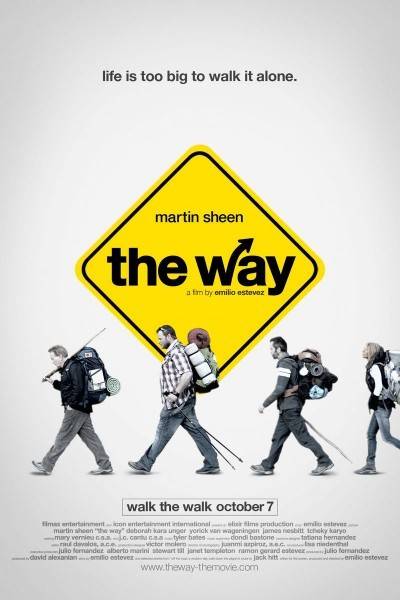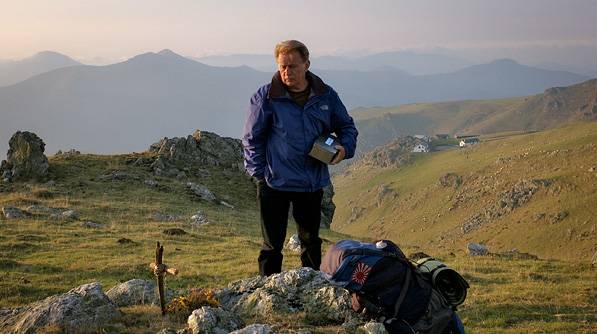The Way, PG-13
 I’ll admit that I was skeptical about a film that was so thoroughly constructed by Emilio Estevez. He wrote, directed, produced, and appeared in The Way, and Martin Sheen, his biological father, stars as his dad in the film. I watched the trailer and I thought that it had a lot of potential. But, come on, a film by Emilio Estevez is going to be good? Well, surprisingly, yes.
I’ll admit that I was skeptical about a film that was so thoroughly constructed by Emilio Estevez. He wrote, directed, produced, and appeared in The Way, and Martin Sheen, his biological father, stars as his dad in the film. I watched the trailer and I thought that it had a lot of potential. But, come on, a film by Emilio Estevez is going to be good? Well, surprisingly, yes.
There are a few moments where it seems Estevez stretches himself too hard to make a meaningful moment. A lot of this is from the I-need-to-make-a-Zach Braff-Garden State soundtrack mentality that seems to resonate at times. I’m not sure how much say Estevez had in those song selections, but it was a little too familiar to have The Shins, Coldplay, and Nick Drake all telling me how to feel about a scene of a movie. They even threw in some James Taylor, David Gray, Live, and Alanis Morissette for extra discomfort. But, as a whole, the film feels genuine, evolves naturally and, more than anything, looks fantastic. The original music by Tyler Bates is phenomenal. The simplicity of the strings, piano, and guitar are a great companion to the vast shots of Spain.
Even if you’re a digital junkie, you should appreciate the fact that The Way was shot on, and presented on, film. The cinematography by Juanmi Azpiroz is reason enough to watch the film. It was shot entirely in Spain and France, along the Camino de Santiago, or the Way of St. James, and it captures both the Spanish and French countryside beautifully. The vivid colors, sunsets, and varied landscapes are framed perfectly along “the way.”

The film’s plot centers around Tom (Martin Sheen) who gets a call from a Captain Henry Sebastian who tells him that his son, Daniel (Estevez), has died in a weather related accident along the Camino de Santiago. Tom is bewildered and finds himself reliving tense moments with his son, with whom he did not have the closest relationship. He pictures himself riding in the car, talking to Daniel about his plan, or lack of one in this case, for his upcoming trip and when he hopes to return. Daniel doesn’t wish to finish his doctorate, but instead live life to its fullest.
It’s interesting to watch father and son together in this scene ― the resemblance is uncanny ― but it somehow felt a little cheesy and forced. I figured their moments together would have been the most genuine. Perhaps they just have a great relationship and it was hard for them to overcome the natural familial bond that they do have. Whatever the case, Daniel tells Tom, “You don’t choose a life dad, you live one,” and we can move on with the story and enjoy the beauty. One of the most touching and authentic moments of the film is a scene in which Tom goes to identify Daniel’s body and he discovers a shell of Daniel’s, which he is told is a symbol for the pilgrimage that Daniel is on, traversing the Camino de Santiago.
Most of the film is spent traveling “the way” with Tom, who decides that he will walk the journey Daniel couldn’t complete and spread his son’s ashes along the way. It’s estimated that it will take about 6–8 weeks to complete, walking 12–15 miles per day.
The journey connects Tom to some new friends: Jack ― a nutty, struggling writer hung up on metaphors, Sarah ― a Canadian with a chip on her shoulder, and Joost ― a hefty, eccentric Dutchman. Tom begins to connect to ― and mirror ― Daniel along his journey, seeing him in the places he had probably already been. And Tom finds all of the comforts, joys, and frustrations that come with close human contact. His friends bring a new dynamic to the film and a sense of comedic relief for the weight of the journey. It’s through Daniel’s death that Tom learns how to live life again.
There’s a beauty in the silences and the purely instrumental scenes especially. Sometimes it’s the lack of words that make the difference and allow you to feel the power. As Jack says in the film, “Writers, they always want the last word. But this…”
3 out of 4 stars
The Way plays at the Art Theater this week. Check the website for updated show times.








